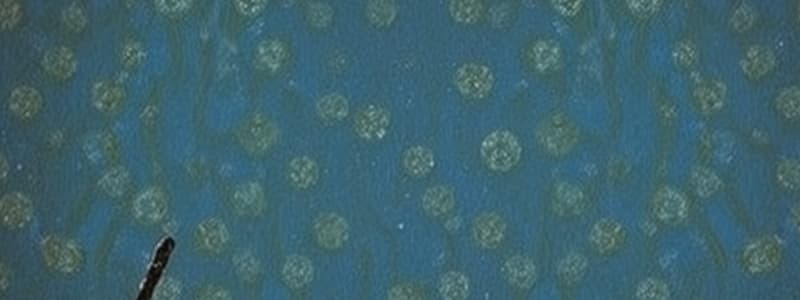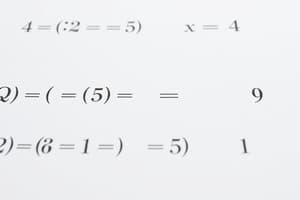Podcast
Questions and Answers
Which of the following is the correct sequence of events in generating an action potential?
Which of the following is the correct sequence of events in generating an action potential?
- Repolarization, hyperpolarization, depolarization
- Depolarization, hyperpolarization, repolarization
- Hyperpolarization, depolarization, repolarization
- Depolarization, repolarization, hyperpolarization (correct)
The primary function of an action potential is to transmit signals over short distances within a cell.
The primary function of an action potential is to transmit signals over short distances within a cell.
False (B)
What is the main structural difference between voltage-gated sodium channels and voltage-gated potassium channels?
What is the main structural difference between voltage-gated sodium channels and voltage-gated potassium channels?
Voltage-gated sodium channels have two gates (activation and inactivation), while voltage-gated potassium channels have only one (activation).
During the absolute refractory period, a second action potential cannot be generated, regardless of stimulus strength, because ______ channels are inactivated.
During the absolute refractory period, a second action potential cannot be generated, regardless of stimulus strength, because ______ channels are inactivated.
Match the following ions with their role during an action potential:
Match the following ions with their role during an action potential:
What is the primary function of the Na+/K+ pump in neurons?
What is the primary function of the Na+/K+ pump in neurons?
The relative refractory period occurs when all sodium channels have returned to their resting state, and a stronger-than-normal stimulus is required to elicit an action potential.
The relative refractory period occurs when all sodium channels have returned to their resting state, and a stronger-than-normal stimulus is required to elicit an action potential.
Why is the action potential considered an 'all-or-none' event?
Why is the action potential considered an 'all-or-none' event?
The resting membrane potential is primarily established by the high permeability of the membrane to ______ ions and the actions of the Na+/K+ pump.
The resting membrane potential is primarily established by the high permeability of the membrane to ______ ions and the actions of the Na+/K+ pump.
Match the following terms related to ion channels with their definitions:
Match the following terms related to ion channels with their definitions:
Which of the following best describes the role of the inactivation gate in voltage-gated sodium channels during an action potential?
Which of the following best describes the role of the inactivation gate in voltage-gated sodium channels during an action potential?
Action potentials propagate more slowly in myelinated axons compared to unmyelinated axons.
Action potentials propagate more slowly in myelinated axons compared to unmyelinated axons.
How does the concentration gradient of sodium and potassium ions contribute to the resting membrane potential?
How does the concentration gradient of sodium and potassium ions contribute to the resting membrane potential?
The period immediately following an action potential during which a neuron is unable to generate another action potential, regardless of the stimulus strength, is called the ______ refractory period.
The period immediately following an action potential during which a neuron is unable to generate another action potential, regardless of the stimulus strength, is called the ______ refractory period.
Match each phase of the action potential with its ion channel activity.
Match each phase of the action potential with its ion channel activity.
Which of the following is NOT a typical property of an action potential?
Which of the following is NOT a typical property of an action potential?
The Na+/K+ pump directly contributes to the repolarization phase of the action potential.
The Na+/K+ pump directly contributes to the repolarization phase of the action potential.
Explain the difference between the absolute and relative refractory periods in terms of ion channel states and stimulus requirements.
Explain the difference between the absolute and relative refractory periods in terms of ion channel states and stimulus requirements.
In myelinated axons, action potentials 'jump' between the ______, a process known as saltatory conduction.
In myelinated axons, action potentials 'jump' between the ______, a process known as saltatory conduction.
Match the following channel types with their triggering mechanism:
Match the following channel types with their triggering mechanism:
Flashcards
What is an action potential?
What is an action potential?
An action potential is a rapid, transient, all-or-none electrical signal conducted along a neuron's axon.
Main events for action potential
Main events for action potential
Depolarization opens voltage-gated Na+ channels, causing Na+ influx and further depolarization. Repolarization occurs as Na+ channels inactivate and voltage-gated K+ channels open, leading to K+ efflux.
Function of the action potential?
Function of the action potential?
Action potentials enable rapid long-distance communication in the nervous system, crucial for reflexes, sensory processing, and motor control.
What is an ion channel?
What is an ion channel?
Signup and view all the flashcards
Refractory periods
Refractory periods
Signup and view all the flashcards
Na+/K+ pump role
Na+/K+ pump role
Signup and view all the flashcards
Study Notes
- Proof strategies involve understanding the claim, making the claim true, and writing convincing steps.
Proofs Involving Quantifiers
- When proving claims with quantifiers, determine the meaning of the claim.
- Before writing steps, validate the claim.
- Write convincing steps to lead the reader to agreement.
Example 1
- Claim: For all real numbers x, if x > 10, then there exists a real number y such that y² = x.
- Proof: Assume x is a real number and x > 10. Let y = √x.
- Since x > 0, y is a real number.
- y² = (√x)² = x
- Thus, there exists a real number y such that y² = x.
Example 2
- Claim: There is a real number x so that for every real number y, we have x ≤ y.
- Proof: Let x = 0. Let y be in the set of real numbers.
- Case 1: If y > 0, then x = 0 < y, so x ≤ y.
- Case 2: If y = 0, then x = 0 = y, so x ≤ y.
- Case 3: If y < 0, then x = 0 > y, so x ≤ y.
Proof by Cases
- For a proof by cases, break up the possibilities into different cases.
Example
- Claim: If n is an integer, then n² + n is even.
- Proof: Let n be an integer.
- Case 1: If n is even, then n = 2k for some integer k.
- Thus, n² + n = (2k)² + 2k = 4k² + 2k = 2(2k² + k).
- Since 2k² + k is an integer, n² + n is even.
- Case 2: If n is odd, then n = 2k + 1 for some integer k.
- Thus, n² + n = (2k + 1)² + (2k + 1) = 4k² + 4k + 1 + 2k + 1 = 4k² + 6k + 2 = 2(2k² + 3k + 1).
- Since 2k² + 3k + 1 is an integer, n² + n is even.
Proof by Contrapositive
- To prove P implies Q (P ⇒ Q), prove not Q implies not P (¬Q ⇒ ¬P).
Example
- Claim: If n is an integer and n² is even, then n is even.
- Proof: Let n be an integer, assume n is not even, then n is odd, so n = 2k + 1 for some integer k.
- Thus, n² = (2k + 1)² = 4k² + 4k + 1 = 2(2k² + 2k) + 1.
- Therefore, n² is odd and n² is not even.
Proof by Contradiction
- Assume the claim is false and show this leads to a contradiction.
Example
- Claim: There are infinitely many prime numbers.
- Proof: Assume not, then there are finitely many prime numbers: p₁, p₂, ..., pₙ.
- Let N = (p₁ ⋅ p₂ ⋅ ... ⋅ pₙ) + 1.
- N is an integer bigger than 1, so N is divisible by some prime number pᵢ.
- pᵢ divides both (p₁ ⋅ p₂ ⋅ ... ⋅ pₙ) and N, so pᵢ divides the difference: N - (p₁ ⋅ p₂ ⋅ ... ⋅ pₙ) = 1.
- But only 1 divides 1, and pᵢ is not 1 since pᵢ is prime, which is a contradiction.
Studying That Suits You
Use AI to generate personalized quizzes and flashcards to suit your learning preferences.




